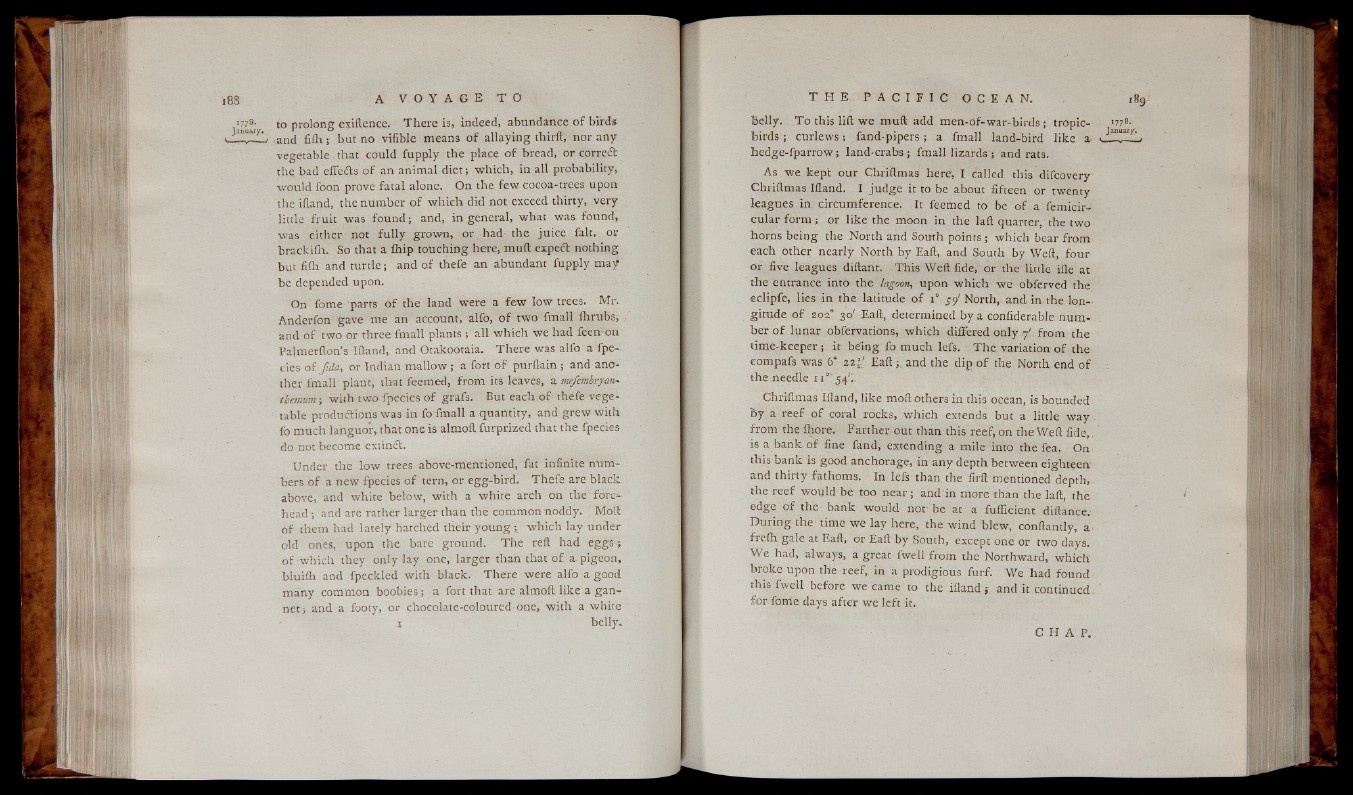
1778.
J a n u a r y .
to prolong exiftence. T he re is, indeed, abundance o f birds
.and f i fh ; but no vifible means o f a lla y in g thirft, nor any
vegetable that could fupply the place o f bread, or correit
the bad effedts o f an animal d ie t ; w hich, in a ll probability,
wou ld foon prove fatal alone. Qn the few cocoa-trees upon
the iliand, the number o f w h ich did not exceed thirty, very
little fru it was fo u n d ; and, in general, what was found,
w as either not fu lly grown , or had the ju ice fait, or
brackifh. So that a ihip touching here, muft expedt nothing
but fifh and tu r tle ; and o f thefe an abundant fupply m a f
be depended upon.
On fome parts o f the land were a few low trees. Mr.
Anderfon ga ve me an account, alfo, o f two fmall fhrubs;
and o f two or three fmall plants ; all w hich w e had feen on
Palmerfton’s liland, and Otakootaia. There was alfo a fpe-
eies o f fida, or Indian mallow ; a fort o f purflain ; and another
fmall plant, that feemed, from its leaves, a mefembryan-
tbemum ; with two fpecies o f grafs. But each o f thefe v e g e table
productions was in fo fmall a quantity, and g rew with
fo much languor, that one is almoft furprized that the fpecies
do not become extindl.
Under the low trees above-mentioned, fat infinite numbers
o f a new fpecies o f tern, or egg-bird. T he fe are black
above, and white below, with a white arch on the forehead
; and are rather larger than the common noddy. Moil
o f them had late ly hatched their yo u n g ;. w hich la y under
old ones, upon the bare ground. The reft had eggs-;
o f which they only la y one, larger than that o f a- pigeon,
blu iih and fpeckled with black. The re were alfo a good
many common boobies ; a fort that are almoft lik e a gan-
n et; and a footy, or chocolate-coloured one, with a white
% belly.
Belly. T o this lift w e muft add men-of-war-birds ; tropic- «778.
birds ; curlews ; fand-pipers ; a fmall land-bird lik e a » J-a"™r- a
hedge-fparrow; land-crabs ; fmall lizards ; and rats.
As w e kept our Chriftmas here, I called this difcove ry
Chriftmas Ifland. I ju d g e it to be about fifteen or twenty
leagu es in circumference. It feemed to be o f a femicir-
cu la r fo rm ; or lik e the moon in the laft quarter, the two
horns be in g the North and South p oin ts; which bear from
each other nearly North b y Eaft, and South by Weft, four
or five leagues diftant. This Weft fide, or the little iile at
the entrance into the lagoon, u p on w hich w e obferved the
eclipfe, lies in the latitude o f 1° ¿9' North, and in the longitude
o f 202* 30' Eaft, determined by a confiderable n um ber
o f lunar obfervations, w hich differed only 7' from the
time-k eep er; it being fo much lefs. T h e variation o f the
compafs was 6° 22 | j E a ft;. and the dip o f the North end o f
the needle 1 i° 54'.-
Chriftmas Ifland, like moil others in this ocean, is bounded
By a re e f o f coral rocks, which extends but a little w a y -,
from the ihore. Farther, out than this reef, on the Weft fid e ,,
is a bank o f fine fand, extending a mile into the fea. On,
this bank is good anchorage, in any depth between eighteen
and thirty fathoms. In lefs than the firft mentioned depth,
the re e f would be too n ea r; and'in more than the laft, the:
edge o f the bank would not be at a fufficient diftance.
Du ring the time w e la y here, the wind blew, conftantly, a
fre ih gale at Eaft, or Eaft by South, except one or two days.
We had, always, a great fwell from the Northward, which
broke upon the reef, in a prodigious furf. We had found
this fwe ll before we came to the ifland ; and it continued. ’
for-fonie days after we left it.